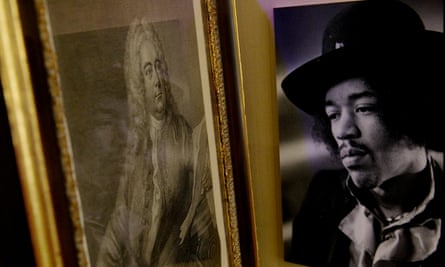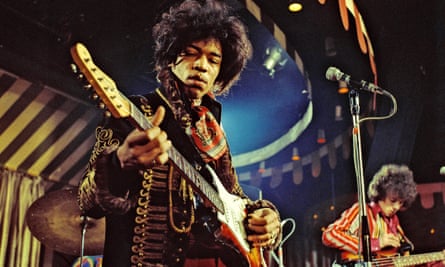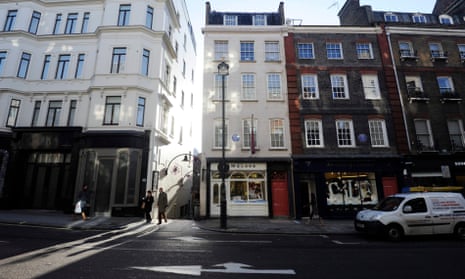A top-floor flat in London, regarded by many as a shrine to the greatest guitarist in the history of rock music, is to open permanently to visitors – creating a double museum to the two famous men who lived in the building: Jimi Hendrix and Georg Frideric Handel.
Restoring the attic flat to its 1960s appearance after half a century of office use and creating new office space for the evicted staff of the Handel House Museum has taken two years and cost £2.4m.
Hendrix’s bedroom has been faithfully recreated and there will be an exhibition about his life and work, including his Epiphone FT79 acoustic guitar, bought in New York and recalled as always within arm’s reach during his time in London.
Handel’s front door has been reopened as the visitor entrance – 23 and 25 Brook Street in Mayfair, central London, were originally separate buildings but have since been knocked together – and a new studio performance space added to the museum.
The Hendrix rooms will open on 10 February 2016, with tickets going on sale from next Monday. Ticketing will allow visitors to choose either Hendrix or Handel, or both.

It will be the only home of Hendrix open to the public anywhere in the world. When he moved into the £30-a-week flat on 4 July 1968, with girlfriend Kathy Etchingham – who has advised on the recreation of the rooms’ appearance – he wrote poignantly: “This is my first real home of my own.”
Long before the Handel House Museum opened in 2001, well-informed music tourists could be seen standing in Brook Street staring up at the tall, narrow Georgian building, then occupied by flats and offices. Handel had been commemorated by a blue plaque since the 1950s, but the Jimi Hendrix connection was only marked in 1997.
Alistair Stranack, chair of the Handel House Trust, said: “It is hard to think of another home in the world with such a concentration of musical genius.”
When Handel’s handsome Georgian rooms were meticulously restored, the museum staff took over the woodchip-wallpapered space of Hendrix’s old bedroom, where they became used to people knocking on the door and pleading to be shown around. A temporary exhibition marking the 40th anniversary of Hendrix’s death was such a success it led to the decision to open the space permanently.
Etchingham found the flat through a small ad in an evening paper. As well as her memories, including shopping trips to John Lewis to buy curtains and cushions, the main living room has been restored by interviewing other visitors about their frequently hazy recollections of raucous parties there, and poring over old photographs and film of the rooms. Nights ended late and days started even later, with the curtains usually staying shut – earning Hendrix the nickname “The Bat”. Evenings often began with a meal at the ground floor restaurant, Mr Love, continued at a jam session at the Speakeasy Club, and ended with a crowd of friends and strangers packed into the small flat.

The guitar was usually kept propped against the bed, Etchingham recalled: “Jimi used it for everything he composed in this country. He constantly played it to work out riffs and song arrangements, including his own version of Dylan’s All Along the Watchtower.”
Hendrix was delighted when he learned of the Handel connection, and went around the corner to One Stop Records in South Molton Street to buy recordings of The Royal Fireworks and The Water Music. Some have even claimed to detect the composer’s riffs in Hendrix’s later music.
Handel lived in the building for almost 40 years, wrote his masterpiece, Messiah, there, and died in his bedroom in 1759, aged 74. Hendrix died in a Notting Hill hotel in 1970, aged 27, allegedly by choking in his sleep after an accidental drugs overdose, though the circumstances of his death are still debated.

Comments (…)
Sign in or create your Guardian account to join the discussion